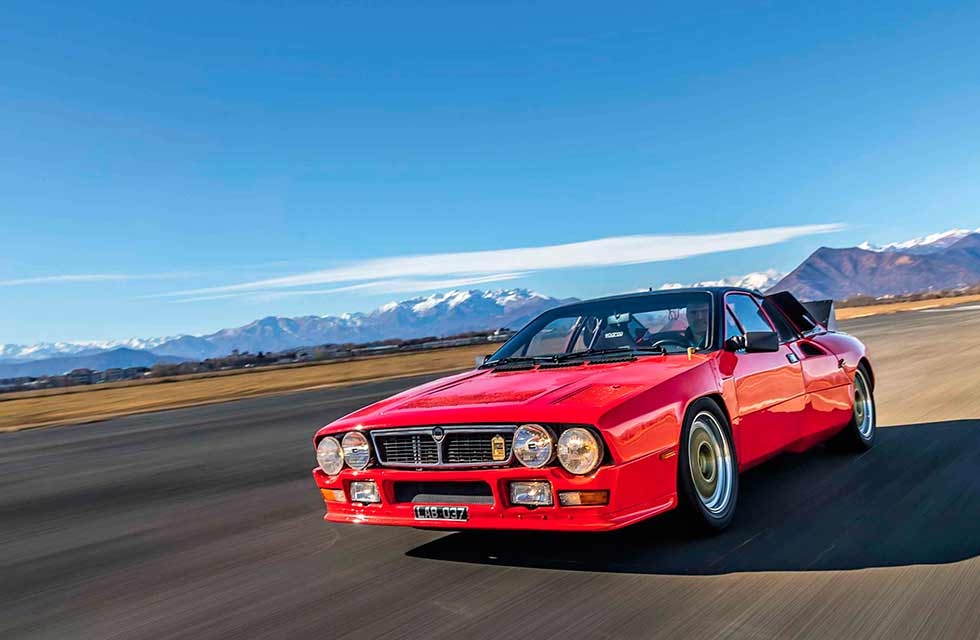
Prototype for the last rear-drive rally champ tested. Lancia’s 037 was the last rear-wheel-drive car to win the World Rally Championship – and this is the original development car, restored by the man who created it. Words Massimo Delbo. Photography Max Serra.
Lancia 037 Prototype More than just a number
In Italian, ‘037’ is zerotrentasette, said as a single word. It’s enough to identify a car, a brand and a whole period in rallying. The Lancia Rally 037 was the last car to win a World Rally Championship with only two driven wheels, a final fling for the old-school, rear-drive David against the four-wheel drive of Goliath. And every rally driver of the period fell in love with it. Giorgio Pianta gave the 037 the nickname of Mamma, because it was so forgiving. It was also beautiful, fast and reliable and became one of the most easily identified and renowned cars of the Group В rally era. While people might say Lancia Fulvia, today enthusiasts simply talk of ‘the 037’ in the same way that saying ‘Elvis’ makes ‘Presley’ redundant.
‘As often happens with prototypes, it was parked outside the Abarth building and forgotten’
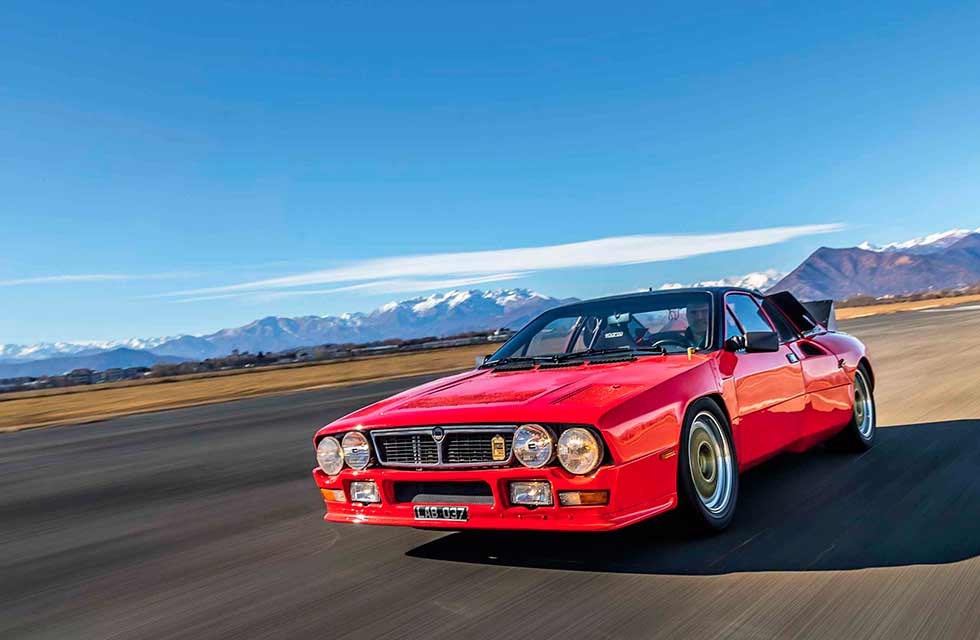
Only around the 200 necessary for Group В homologation were built. A number of works cars – campaigned by the top drivers of the day, and wearing the distinctive Martini livery – have their own places in the story of rallying. There is one car, however, that deserves a particularly special place in 037 history: chassis number 1, or as its maker had it, ZLA.151AR0.0000001, with an added tag stamped ‘Abarth SE037-001’. This car is the very first 037 built, created (and adored) by Lancia Abardi Rally department boss Sergio Limone. He was 32 years old then. When he retired, he rescued 037 no 1 and restored it himself.
‘The end of 1979 and early 1980 was not an easy time because there was a lot of confusion in rallying,’ Limone tells me. ‘I was in charge of the Lancia Abarth Rally technical department, because Mario Colucci, father of the 131 Rally,
resigned at the end of ’1978 and Pier Paolo Messori, who would become the father of the Lancia Delta S4, joined later, leaving me in the enviable but risky position of being forced to decide by myself.
‘The rules were changing, but FISA was late, very late, in defining them, and we knew we had to act just to be on time at the end of 1981 or early 1982, when the new rules would be applied. We knew that four-wheel drive and turbocharged engines were the future, but we also knew we weren’t ready. Our competencies in both weren’t as good as we would have hoped, and going down that road then would mean we’d lose, for sure.’
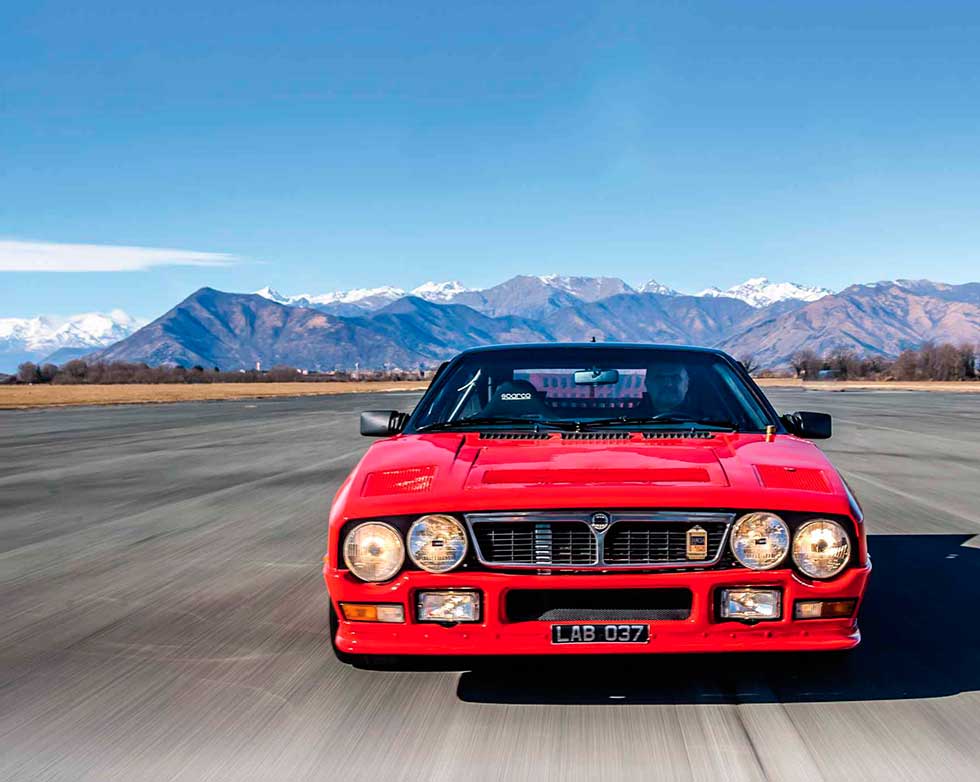
Limone and his team evaluated several options, including a Fiat Ritmo (Strada) with a mid-mounted engine (as in the Renault 5 Turbo), and a Lancia Delta with a Ferrari engine, rear transaxle and a tubular chassis. Named 036, this was later developed as the Delta S4.
‘When we started to move forward, we didn’t know yet which marque we were preparing for, whether Fiat, Lancia or simply Abarth. What experience taught me is that, in a project with many unknowns, to hope for success means you have to keep everything as simple as possible.’
And so Limone looked at the Lancia Beta Montecarlo: ‘To me it was perfect, easy to achieve, with a bigger cockpit than the Stratos and experience already in racing in Group 5 – which was coming to an end, leaving us with plenty of unused material and an Abarth chassis, something we knew had always been very good indeed. I “borrowed” a standard Montecarlo from the press department and started working on it, widening the front track and making more space for the suspension, lengthening the wheelbase and so on. I have no problem admitting that I often asked for help from my old boss, Ingegnere Colucci, a dear friend and a real gentleman; in endless evening talks he provided me with very useful information.

‘The rear suspension in the 037 is really his creation. As for the gearbox, I found the unit used on the De Tomaso Pantera and BMW M1 E26 in racing to be perfect for this application: it was very robust and long enough to give me plenty of space for bigger differentials. For the suspension, I hate the MacPherson system: fragile and the origin of many problems during its career on the 131 Rally. I preferred wishbones. Using the Montecarlo as a base had an additional benefit, because it made easier what we thought would be – though we were not then 100% sure – the mandatory production of at least 200 for homologation.’
And so, early in 1980, the project gained definition: ‘We started with the naturally aspirated four-cylinder 131 Rally engine and we were moving very fast indeed,’ says Limone, ‘but I knew that if I had to wait for the car to be completed by Pininfarina, I had no hope of finishing in time. This is when I decided to take the last unused Group 5 chassis to Ingegnere Giampaolo Dallara and his amazing team, who still had the references and the jigs to create the Group S Montecarlo. By September 1980 “my” car was ready, and would be tested before Christmas – not bad at all, considering that the first sketches were made in mid-1980!
‘That was when I started working on a body shape, too. Pininfarina had been assigned the design, but I needed something before they were ready, and, loving the Ferrari 308, I took some characteristic details of that car, such as the round tail-lights and the air intake above the front wings. To me, the main point was accessibility and ease of construction and maintenance, and the car seemed to look right, even if, when Pininfarina’s Leonardo Fioravanti saw it for the first time, he cried! I made several styling mistakes: above all, using front lights from the Fiat 131, of two diameters, positioning the larger one outside. Fioravanti told me straight: it makes the car look sad. He was right, and the final body, designed by Enrico Fumia, is so much better-looking’.

Of course, Limone’s target was to win rallies, not beauty contests. ‘The idea of the big air intake behind the cockpit, in a higher position, was mine’ – he says. ‘The first design of Pininfarina had them lower, but in a rally they would have been blocked by dust and mud, so I had them moved higher. It looked good, too!
Shortly after, a second prototype was built to develop the roadgoing Stradale version and often the two cars were seen together. By January 1981, chassis #1 was at Pininfarina for wind tunnel tests with different spoilers and wings, and by March it was lapping Pirellis Vizzola Ticino test track.
‘The two cars were heavily used to develop the final versions of the competition car and the road car’ says Limone. ‘On one occasion, Messori drove the Stradale to Piacenza for a meeting about 150km away. He put his jacket in the boot and, when he arrived, found what was left of a sleeve flapping about, because above a certain speed the lid was opening! Remember, these were Group В cars, built very quickly to reach the required number as soon as possible. As for comfort, even for the Stradale, the view was simply that it should not be too shaky and have a noise level below the threshold of physical pain!’
The competition prototype proved to be good from day one, with glowing reports from the test drivers. ‘At the end of April 1981 we had the great test with Giorgio Pianta, at La Mandria, the Fiat test ground around Turin/ says Limone. ‘Its a sort of park, with beautiful roads, even if some are dirt tracks. Pianta always had the best lap time, even compared with the works drivers, Walter Rohrl and Markku Alen. At La Mandria, he immediately loved the 037’.
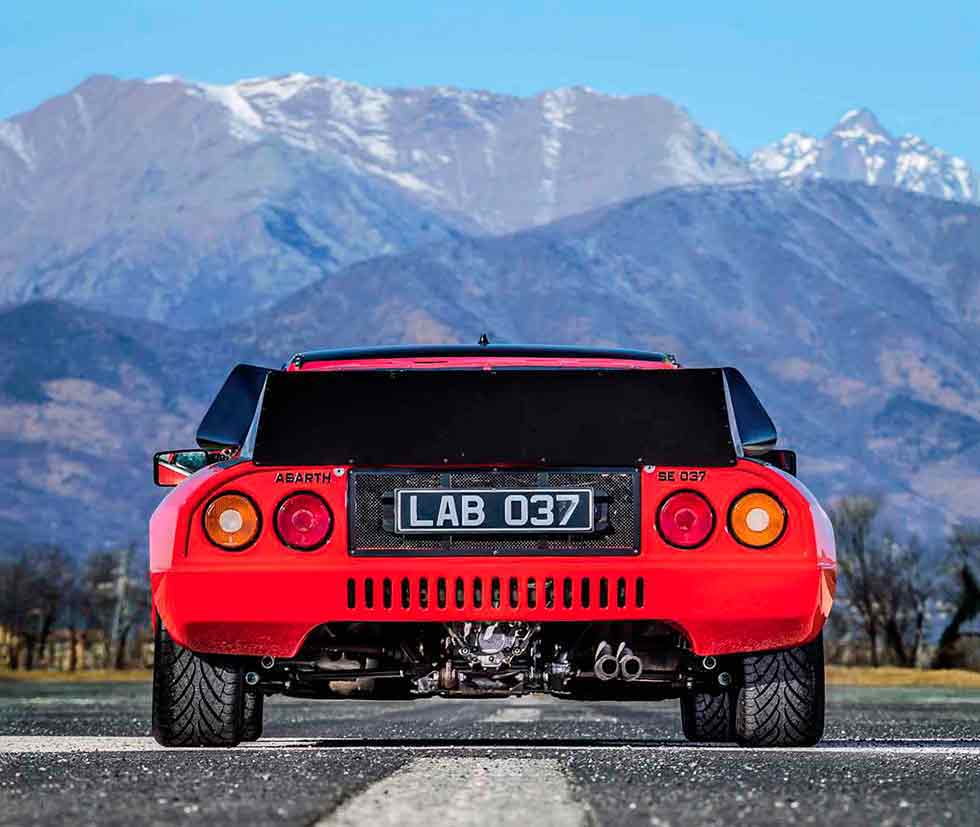
On 11 May 1981, at Campo Volo, a turbocharged engine was installed in car no 1. This 1750cc Montecarlo unit was powerful but had too many technical issues to solve, including terrible turbo lag due to the size of the turbine. And so the idea grew within Abarth of developing a supercharged engine. ‘We knew the technology better than turbos’ – admits Limone, ‘and since 1977 we had engineering maestro Aurelio Lampredi as Abarth president. Its a name that needs no introduction, a man with such a strong character, one you don’t want to argue with. Since the 1950s, when he was racing with this technology while at Ferrari, he considered it the best solution for an engine, because of its constant boost and its lightness. The only problem was that we’d have to build our own because there weren’t any supercharger manufacturers! We went so far with that, even testing a turbo and supercharger combination, a solution that we would develop fully for the S4.’
Markku Alen tested the newly supercharged car in January 1982, and after only a couple of laps stopped and declared it ‘no problem’. The 037 was homologated from 1 April, yet manufacturing had already begun because Lancia team manager Cesare Fiorio decided to take the risk and get production underway beforehand to save time. Testing and development with car no 1 was coming to an end, and it entered the works team as the reserve car. Painted in Martini colours, it arrived in Greece during the first week of April 1982, just in time for the Acropolis Rally.
Then, as often happens with prototypes, it was parked outside the Abarth building and forgotten. ‘I saw her every day, parked in all weathers behind car no 3, looking ever-more sad and neglected, and getting closer to the point at which, usually, the cars were scrapped,’ says Limone.
‘I started thinking about saving it, and in June 1983 I asked my general manager, Fabio Massimell, if I could buy it and, with a lack of red tape that would be inconceivable today, he agreed. He asked me why and I replied that this was my first car. I still have the shipment note, dated 30 June 1983, in which there is the description of my purchase: a crashed chassis – it wasn’t, but “crashed” made it cheaper for me to buy it! – an Ml gearbox, two front and two rear wheels. I have a picture of the car on the trailer: a mix of colours and parts, but complete.
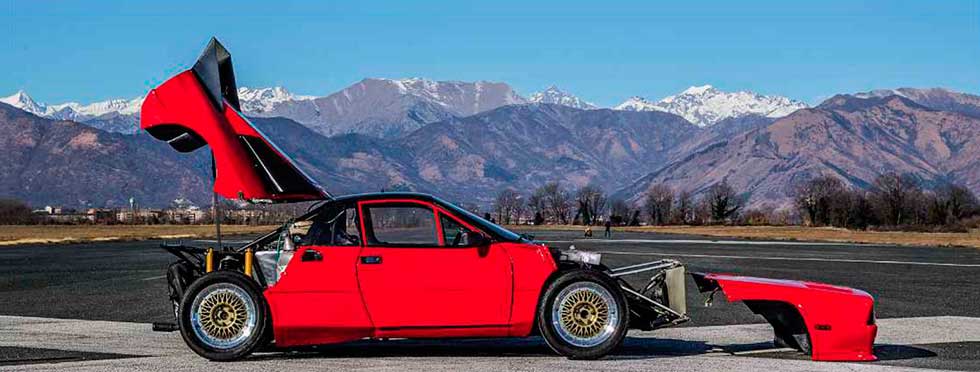
‘It took about ten years to return it to its mid-1981 configuration, and much of the work was carried out with the help of my old Abarth colleagues. It is equipped with an engine that runs on Kugelfischer fuel injection, and the small compressor of the type used on the road-legal engine, not too powerful but easy to tune and reliable.’
And so, finally, Limone got to enjoy his creation, but only for so long. ‘In 2010, I was having trouble finding somewhere to store the car, and at the Vernasca Silver Flag I met an old friend and collector willing to have her. So I sold her. I miss her, but today I’m too old to enjoy the car in the right way. Being back here today at Campo Volo with her floods me with emotions. She has been an amazing chapter of my professional and personal life, and I’ll never forget the hard work she did for us.’
A short drive redefines the meaning of a noisy car, but at the same time I enjoy a sense of perfect roadholding, of a beautifully balanced machine that is as easy and natural to steer with the throttle as with the wheel. Enter a corner fast enough to provoke understeer and you can enjoy correcting it by flooring the accelerator and counter-steering to achieve the most spectacular yet easily controlled powerslide. I feel like a child having fun under the benevolent yet protective eye of a parent, and in doing so I fully understand why Giorgio Pianta raved about it all those years ago.
I also have to remind myself that this is not a ‘normal’ 037, if any such thing exists, but car number 1, an irreplaceable piece of rallying history. It has been a very special day.
THANKS TO Max Girardo and Marcus Willis of Girardo & Co (girardo.com).
Below and opposite Being the development car, chassis no 1 has many unique features, including its four-tail-lights and rather rudimentary but pleasingly functional air scoop.
Opposite page Drive-My’s Massimo Delbo gets a stint at the wheel; mid-mounted engine was based on Fiat 131 unit but heavily reworked by Abarth and supercharged. Above Early test session at Campo Volo in November 1980, with Giorgio Pianta at the wheel; Sergio Limone, back at the same location this year with the car he created.
LEADING FROM THE REAR
How the rear-drive 037 defeated the all-wheel-drive Quattro
Following in the tracks of the legendary Stratos, the 037 Rally made almost as big an impact in International rallying in the 1980s as its illustrious forebear had in the preceding decade.
When it made its competition debut proper in 1982, the 037 was as revolutionary as the Stratos had been in 1972. It was one of the first of the Group В supercars and owed much to circuit racing practice. A mid-engined two-seater with Kevlar bodywork, its Fiat-sourced 2.0-litre four was considerably reworked by Abarth (by then part of the Fiat-Lancia family) and fitted with a light-alloy, 16-valve twin-cam head and Roots-type supercharger to produce around 300bhp.
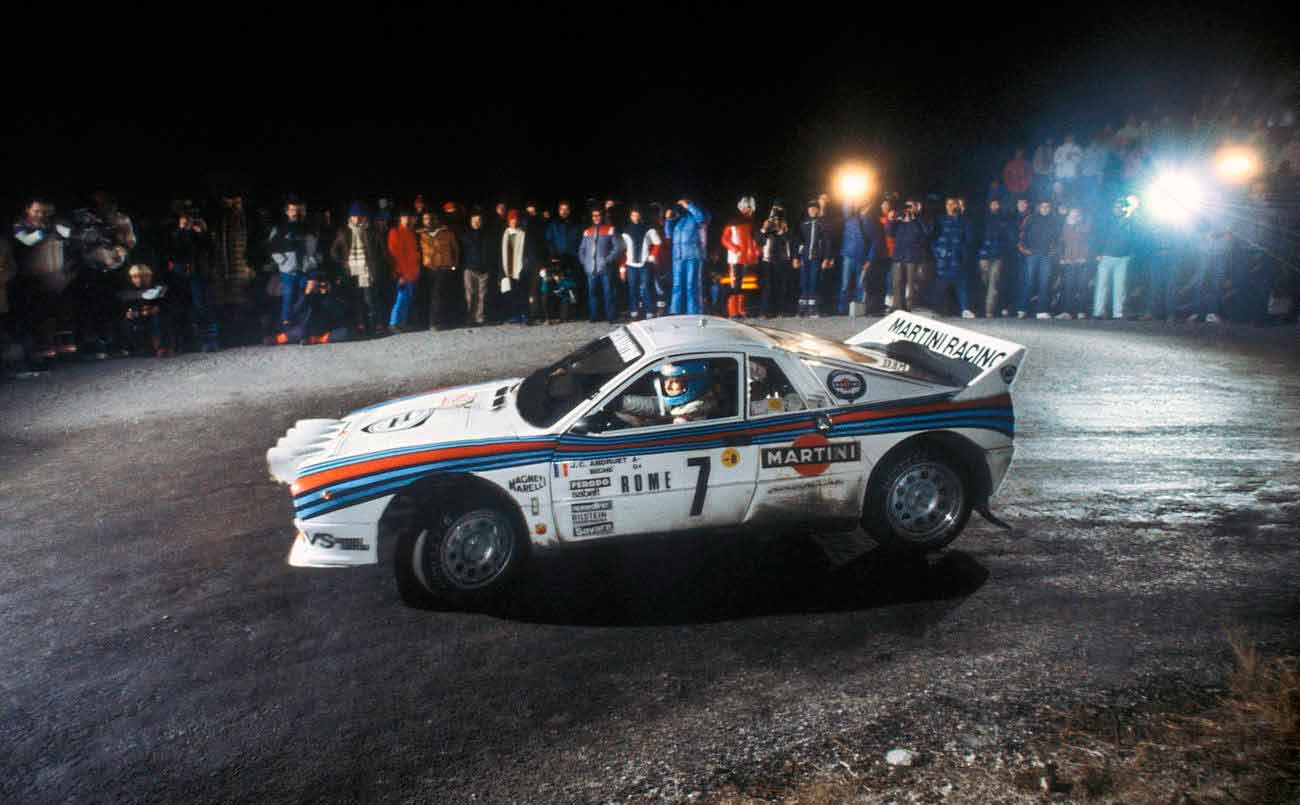
The first season it was dogged by reliability issues, but in 1983 all the stars aligned. The 037 was quick, it was agile, it was reliable, and Lancia had an outstanding roster of drivers at its disposal, including Attilio Bettega, Walter Rohrl and Markku Alen. A ding-dong battle with the Audis ensued, Lancia eventually winning the Constructors’ Championship by just two points. The following year the Quattro forged ahead, but by then the 037 had secured its own place in rallying history.
1980 Lancia Abarth Rally SE 037
Engine 1995cc four-cylinder, DOHC, dry-sump lubrication, fuel injection, supercharger
Max Power c270bhp @ 8000rpm
Max Torque c220lb ft @ 5000rpm
Steering Rack and pinion
Transmission Five-speed manual transaxle, rear-wheel drive
Suspension
Front: double wishbones, coil springs, Bilstein telescopic dampers, anti-roll bar.
Rear: double wishbones, coil springs, twin Bilstein dampers per side
Brakes Discs
Weight 1040kg
Top speed 142mph
0-62mph 5.7sec






